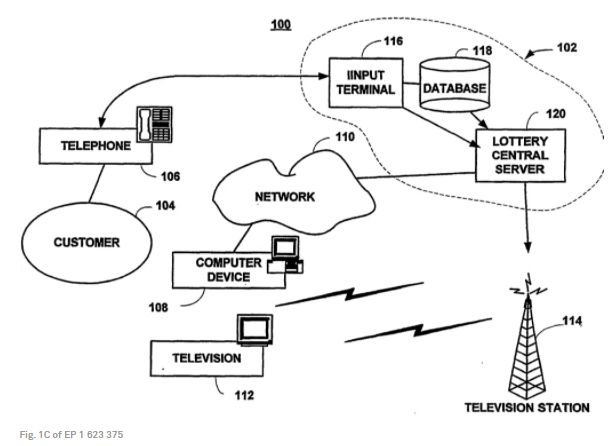This decision is a good reminder that the technical implementation of an otherwise non-technical method has to be rather specific to be patentable. The more high-level and functional the implementation is claimed, the lower the chances of success at the EPO.
Here are the practical takeaways from the decision T 0886/14 (Lottery game/Al-Ziyoud, Aiman H.) of 16.11.2020 of Technical Board of Appeal 3.5.01:
Key takeaways
The technical implementation is only claimed in functional terms and there are no details of how it is actually achieved. Hence, at the level of detail of claim 1, the advanced effects of reducing latency and redundancy are not further technical effects which could give rise to an objective technical problem.
The invention
This European patent application concerns a system for playing a lottery game with a progressive accumulative jackpot. The jackpot grows with each lottery ticket because a portion of the purchase price goes into the jackpot.
The lottery system described in the application comprises a central lottery system connected to a number of remote communication devices via a public telecommunications network:

Fig. 1C of EP 1 623 375
The players use their communication devices to request lottery tickets from the central lottery system. The central lottery system comprises an input terminal, e.g. a web server, for receiving the request from the remote communication device, a central server, and a database for storing the jackpot size.
Having received the ticket request, the central lottery system assigns the requested number of lottery tickets to the player and bills him. Next, the system updates the jackpot size in the database by adding to the jackpot (a portion of) the price of the purchased tickets. The updated jackpot amount is then provided to the central server, which transmits it to a presentation device for display.
Here is how the invention was defined in claim 1:
Is it patentable?
The first-instance examining division had refused the application for lack of inventive step. The argument was that claim 1 then on file addressed the problem of defining rules for playing a game, automation of administrative methods, and presenting information, whereas the implementation of these aspects included only the use of conventional computing components.
The board of appeal agreed with the examining division that a conventional client/server system was an appropriate starting point for assessing inventive step in this case. Claim 1 was found to differ from a conventional client/server system in that
- the server receives, from the remote client, one or more lottery purchase orders,
- stores the accumulated jackpot amount ("latest lottery prize amount" in claim 1),
- updates the jackpot amount automatically based at least partially on the received lottery purchase price, and
- provides the updated jackpot value to a presentation device automatically when the jackpot value has been updated.
According to the appellant, the claim defined an asymmetric information path between a user and the server. The user inputting the lottery purchase order to the server did not receive the latest jackpot amount; the jackpot amount was instead broadcast to prospective users via television, radio, or a website. This was a difference over the conventional client/server system where data exchanged between a client and a server always followed a symmetrical path. But the board did not follow this argument:
In the Board's view, however, the claim does not exclude that the remote communication device and the presentation device is one and the same device. Indeed, according to the application (see page 12, lines 21 to 22 and lines 25 to 26), the presentation device can be a computer device providing displaying capabilities.
In any case, the presentation is not limited to television, radio, or a website. Furthermore, the claim wording covers not only broadcast but also unicast and multicast. Therefore, the Board does not agree that the alleged asymmetry is present in claim 1.
Irrespective of this finding, the board also noted that the requirement that the jackpot value be provided to all players, including prospective players, is a non-technical one:
Like the examining division, the Board takes the view that the claimed subject-matter aims at implementing a method for playing a lottery game, which, when taken as such, would be excluded from patentability pursuant to Article 52(2)(c) and (3) EPC.
The non-technical method of playing a lottery game comprises:
- One or more players request and purchase one or more lottery tickets.
- The lottery is organised by a lottery organiser.
- The lottery scheme includes adding a portion of the purchase price to an accumulative jackpot.
- Each time the jackpot value is increased, it is immediately notified to the requesting lottery player or all lottery players.
Under the COMVIK approach (see decision T 641/00) the non-technical features cannot contribute to inventive step.
The appellant argued that the invention produced a number of technical effects. For example, the server transmitted only the updated jackpot value which avoided a wasteful and redundant transmission of values that have already been transmitted. Furthermore, the server provided the updated jackpot value in real-time and not following some delay. As a result, the technical effect of reducing latency in data transmission was provided. But also these arguments did not succeed:
The Board considers, however, that the effects advanced by the appellant are not (further) technical effects counting towards inventive step. The non-technical method includes that a jackpot value should be provided without delay when it is updated. It follows that the effects advanced by the appellant result from the lottery method per se rather than from its technical implementation. The technical implementation is only claimed in functional terms and there are no details of how it is actually achieved. Hence, at the level of detail of claim 1, the advanced effects of reducing latency and redundancy are not further technical effects which could give rise to an objective technical problem. Furthermore, any asymmetric information exchange would also be a direct result of the non-technical requirement that the jackpot value should be provided to all players.
The Board notes that this finding is in line with the established case law represented i.a. by decision T 258/03 (see points 5.6 to 5.7 of the reasons) and decision T 172/03 (see point 22 of the reasons).
In the appellant's opinion, the objective technical problem was how to provide a platform for the implementation of a lottery capable of providing both participants and prospective participants real-time data about the jackpot total. The Board considered, however, that this problem was not correct ...
... as, contrary to the COMVIK-principle, it does not comprise all parts of the above non-technical method for playing a lottery game. In line with the COMVIK-principle, this method cannot contribute to inventive step and is instead provided in its entirety to the technically skilled person as part of the framework of the objective technical problem. Hence, in the Board's judgement, the skilled person faces the objective technical problem of implementing the lottery method on the conventional client/server system.
Furthermore, the Board considered that the claimed implementation would have been obvious to the skilled person facing the above problem:
In particular, it would have been obvious to implement the lottery game functionality including maintaining and updating a jackpot at the central server. Indeed, it is already given as part of the game rules that the lottery is organised centrally. It would also have been obvious to implement functionality for requesting tickets at client computers connected to the server; this could be done for example using web page forms provided from the server to the remote devices. Finally, providing the jackpot value to all participating players could be straightforwardly accomplished for example by sending automatically generated emails to all players' client computers and by displaying their content.
The appellant also argued that it would not have been obvious at the priority date to present the exact value of the updated jackpot, because lottery systems known at that time rather presented an estimated jackpot amount. But also this argument was not successful:
However, the question whether the skilled person would consider notifying the exact value of the updated jackpot to players in real-time does not arise here, because that has already been decided in formulating the objective technical problem. Therefore, the skilled person would seek to provide such functionality because the problem requires him to do so regardless of whether lottery schemes adopted this solution at the priority date or not. The only question is how it would be done, but, as outlined above, the Board considers the claimed implementation to be obvious.
Therefore, the board concluded that claim 1 did not involve an inventive step, and dismissed the appeal.
More information
You can read the whole decision here: T 0886/14 (Lottery game/Al-Ziyoud, Aiman H.) of 16.11.2020
The content of this article is intended to provide a general guide to the subject matter. Specialist advice should be sought about your specific circumstances.

